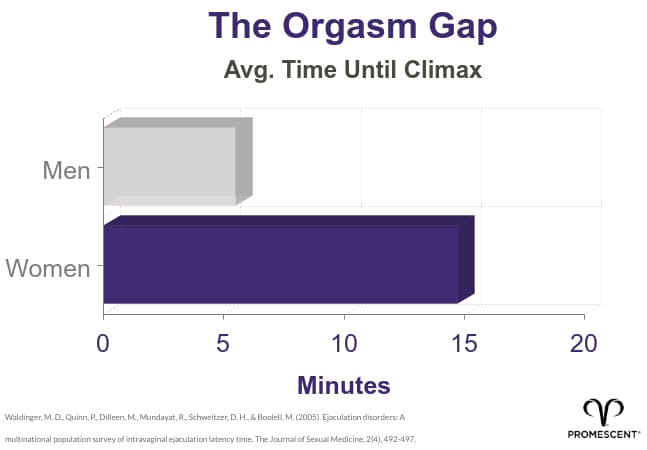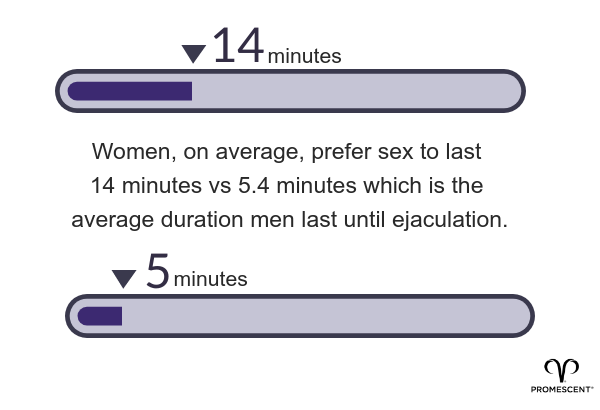The orgasm gap can put a real strain on your relationship. We'll help you close the gap with these tips and techniques.

reviews

reviews

Men orgasm more consistently during sex than women. But just how big is this “orgasm gap?”
In a study of more than 50,000 adults, researchers asked men and women to estimate the percentage of time they reached orgasm during sex in the last month.
For heterosexual men, the number was 95%. For heterosexual women, it was just 65%.

In other words, whereas men are almost always orgasming, women are only doing it about two-thirds of the time.
Unfortunately, a lot of men don’t seem to recognize this and incorrectly believe that their partners are orgasming far more than they actually are.
According to the National Survey of Sexual Health and Behavior: a nationally representative US study of nearly 6,000 adults
It turned out that 85% of male participants told the survey team that their partner had an orgasm during their last sexual event.
But how many women actually reported having had an orgasm during their last sexual event? Just 64%.
The orgasm gap refers to multiple research resources that show a consistent disparity of time between the average duration a male reaches climax compared to the average duration it takes for a female to reach climax from penetration.
There are various reasons why the orgasm gap exists but the most probable reasons involve the lack of knowledge men have about the female anatomy, lack of foreplay, and men putting a higher value on their pleasure over women’s pleasure.
For men, the best thing you can do is expand your knowledge of the female anatomy, put more focus on pleasuring your female partner, and try more foreplay. A great way to start in becoming good at foreplay is to explore sexual enhancers.
Although this survey didn't specify the gender of the person that people had last sexual event with, it’s clear that the difference in men’s and women’s reports can’t be explained by the responses of gay and bisexual men, who only made up a small percentage of survey respondents.

The orgasm gap is sometimes referred to as “the pleasure gap” and it refers to a consistent disparity we see in the research:
Women tend to have far fewer orgasms during sex than men do.
The exact size of the disparity varies by study.
For example, while the aforementioned studies put women’s rate of orgasm at 64-65%, other studies put it much lower - below 40%.
By contrast, men report numbers above 90% like clockwork and in some studies, it gets close to 100%.

However, this problem is specific to relationships between men and women.
When researchers poll gay and lesbian people, the orgasm gap all but disappears.
In the aforementioned study of more than 50,000 adults, reported rates of orgasm for gays and lesbians were:
When you look at bisexual persons, the size of the orgasm gap is similar to the one in heterosexuals: bisexual men report orgasming 88% of the time, compared to 66% for bisexual women.
So why does the orgasm gap exist? There are several contributing factors.
Pro Tip: Check out this Promescent article on the best sex positions for female orgasm

According to a study by the North American Society for Pediatric and Adolescent Gynecology, as many as 44% of college men could not identify the clitoris, a number that coincidentally (and suspiciously) resembles the percentage of women who don't come regularly.
However, it’s not just men who aren’t experts on female genital anatomy.
A surprising number of women are lacking in this knowledge, too
In this study, 29% of college-aged women couldn't identify the clitoris either.
The clitoris is a fascinating organ.
In that, it’s the only organ in the human body that has the sole purpose of providing pleasure.
Much has been made about how the clitoris possesses a larger concentration of nerve endings than the head of the penis.
In other words, it’s a very sensitive organ!
However, there’s much more to the clitoris than what can be seen by the naked eye.
The visible portion is actually just the tip of the iceberg.
Below the surface is a complex structure that wraps around the vagina and other internal organs.
It is, partially composed of erectile tissue too, just like the tissue that makes penises become erect.
In fact, the clitoris and the penis actually come from the same embryonic tissue.
Pro Tip: Check out this great article on clitoral erections to find out everything you need to know.
Male and female fetuses actually start out identical when they’re developing in the womb and their genital structures can develop either way, depending on hormonal exposure.
The internal portion of the clitoris is also thought to be part of what makes "G-spot" stimulation so pleasurable.
In fact, researchers now believe that the G-spot isn’t a distinct piece of female anatomy, but rather the part where the clitoris, vagina, and urethra all come together.

Women need to be sexually aroused prior to vaginal penetration in order for sex to be pleasurable.
During arousal, the vaginal walls lubricate and the vagina itself actually expands and lengthens.
Partners need to allow time for arousal to build; otherwise, sex can be uncomfortable and even painful for women.
Thus, not considering foreplay or not having enough foreplay is a major reason for the orgasm gap.
Oral sex is a particularly important part of foreplay when it comes to the female orgasm.
In fact, many women find it easier to orgasm through oral sex than through vaginal penetration.
However, women don’t receive oral sex as often as men.
A recent study revealed that 44% of women reported receiving oral sex from their partner, compared to 63% of men who said the same.

Female sexual pleasure hasn’t always been put on par with male sexual pleasure.
Women’s orgasms haven’t historically been viewed as being as important as men’s, in part, because pregnancy can potentially happen regardless of whether a woman reaches orgasm; by contrast, the male orgasm (and ejaculation specifically) is typically seen as a vital part of reproduction.
When the primary purpose of sex was seen through a reproductive lens, women’s orgasms just weren’t valued.
However, as society has moved away from this view and toward the view that sex is primarily for purposes of pleasure and enjoyment, women’s pleasure has taken on greater importance—but it’s still not quite valued to the same extent as men’s.
 A study of 500 heterosexual couples reported that the average intravaginal ejaculation latency time (IELT), or how long it takes a man to orgasm once intercourse commences, is 5.4 minutes.
A study of 500 heterosexual couples reported that the average intravaginal ejaculation latency time (IELT), or how long it takes a man to orgasm once intercourse commences, is 5.4 minutes.
Other studies have replicated this result within a few seconds, which tells us that most guys seem to come within 5-6 minutes after penetration.
However, there is a vast range of IELTs—anywhere from 44 seconds (which most sex therapists agree is too short), up to 44 minutes (which most sex therapists think may actually be too long).
That said, when you look at how long women want sex to last on average—about 14 minutes—that’s well more than how long the average guy lasts.
Pro Tip: Check out Promescent Desensitizing Delay Spray. The #1 Doctor recommended over-the-counter PE treatment option.
A 2018 survey conducted by One Poll found that an average of 4.5 bad sexual encounters tended to spell the end of a relationship.
What constituted a bad sexual encounter?
For the women surveyed, 44% cited lack of orgasms, while 57% cited a lack of adequate foreplay.
What this tells us is that if you’re partnered with a woman who isn’t orgasming regularly, it may very well mean the end of the relationship at some point.

Now that you know what the orgasm gap is, here are some suggestions you can act on to close it.
We’re living in the information age.
However, skip the porn and check out some educational videos instead. Read articles and books. Look at pictures.
Learn to recognize the different parts of the vulva, including the clitoris, the inner and outer labia, the vaginal opening, and more.
Of course, every set of genitalia will appear at least a little different, but if you possess the basic knowledge, you will be able to identify everything and find your way around with confidence and ease.
Don’t be afraid to ask your partner what she likes, either. In fact, you should ask because different women find different things to be pleasurable.
If she’s someone who hasn’t spent a lot of time exploring her own body, explore it with her.
You're there to help, but it's her orgasm.
The journey has to start with her, so make sure she knows that she has a supportive partner who is along for the ride.

Combining clitoral stimulation with vaginal penetration is key.
A 2018 study published in the Journal of Sex and Marital Therapy reported that 37% of women required clitoral stimulation in order to reach climax.
The numbers in other studies are even higher, so don’t neglect it.
However, you should keep in mind that the clitoris isn’t just the external portion that you can see.
Understanding the clitoris as part of a bigger structure can allow you to take a more holistic approach to pleasure your partner—and you just might learn something profound about her body in the process.

Remember the studies finding that men last about 5.4 minutes, whereas women want sex to last more than twice as long?
It can be difficult to build up that much stamina, but you can supplement it with more foreplay.
Take your time with kissing, grinding, undressing, and moving from room to room.
Light candles, break out aromatics, turn on the music. Use your fingers, your mouth. Explore each other’s bodies. Consider incorporating toys, too.
Pro Tip: Promescent has a great line of premium adult sex toys that are perfect for couples or solo play.
For example, if you’ve already orgasmed, you can keep kissing her and using a vibrator on her until she’s satisfied.
Also, postpone penetration until she is fully aroused, and maybe until she has already had an orgasm.
Many women can experience multiple orgasms.
While manually or orally stimulating your partner, find a sexy way to ask for directions: “How does that feel? Do you like it when I do this?”
If she’s not much of a talker in bed, pay attention to her non-verbal cues—her moans, groans, and breathing.
A lot of sexual communication is non-verbal because many of us find it difficult to say what we really want and like.
Above all, work on creating strong sexual communication and trust in your relationship.
Make sure she knows that she is welcome to tell you anything and everything that will help you please her.

Check-in with your partner after sex.
Ask how it felt, what they liked, what they want to try next time.
Don’t just talk about sex during sex—make it a regular part of your conversations.
By normalizing sexual talk in this way, it will become easier for both of you to say (and get) what you want out of sex.
Much to the chagrin of many women, a lot of guys think that sex is over once he orgasms. But it doesn’t have to be.
Yes, many men lose their erections quickly after ejaculating, but remember what we talked about above—sex isn't just about penetration.
There are a lot of other ways you can keep things going!
Stay in the game with your hands, your mouth, a vibrator, whatever. Ask your partner what she wants, and remember, you're not the only one here!

Most of us are on the same page about wanting to close the orgasm gap
Regardless of gender, we want our partners to orgasm because it’s a highly erotic experience and a sign of immense pleasure.
Many people also view their partner’s orgasms as an accomplishment and sign of sexual skill; however, just be careful not to put pressure on your partner to orgasm.
By all means, do everything you can to help your partner have the most pleasurable experience possible, but avoid pressuring them because that can actually backfire and make orgasm less likely.
That said, there’s a lot we can do to close this gap, and it starts by enhancing your sex education and building up your sexual communication skills.
The orgasm gap matters, and we're all in to close it.
Dr. Justin Lehmiller is a social psychologist and Research Fellow at The Kinsey Institute. He is author of the blog Sex and Psychology and the popular book Tell Me What You Want: The Science of Sexual Desire and How It Can Help You Improve Your Sex Life. He is also a prolific researcher who has published more than 50 academic works, including a textbook titled The Psychology of Human Sexuality that is used in college classrooms around the world. Dr. Lehmiller is one of the media's go-to experts on sex and has been interviewed by The Wall Street Journal, The New York Times, and CNN; he has also appeared on dozens of radio, podcast, and television programs.
Absorption Pharmaceuticals LLC (Promescent) has strict informational citing guidelines and relies on peer-reviewed studies, academic or research institutions, medical associations, and medical experts. We attempt to use primary sources and refrain from using tertiary references and only citing trustworthy sources. Each article is reviewed, written, and updated by Medical Professionals or authoritative Experts in a specific, related field of practice. You can find out more about how we ensure our content is accurate and current by reading our editorial policy.
David A Frederick, H Kate St John, Justin R Garcia, Elisabeth A Lloyd. 2018 January. Differences in Orgasm Frequency Among Gay, Lesbian, Bisexual, and Heterosexual Men and Women in a U.S. National Sample. PubMed. https://pubmed.ncbi.nlm.nih.gov/28213723/. Accessed 29 Jan2022.
Indiana University Bloomington Staff. (n.d). National Survey of Sexual Health and Behavior. Indiana University Bloomington. https://nationalsexstudy.indiana.edu/keyfindings/index.html. Accessed 29 Jan 2022.
David A Frederick, H Kate St John, Justin R Garcia, Elisabeth A Lloyd. 2018 January. Differences in Orgasm Frequency Among Gay, Lesbian, Bisexual, and Heterosexual Men and Women in a U.S. National Sample. PubMed. https://pubmed.ncbi.nlm.nih.gov/28213723/. Accessed 29 Jan2022.
William Volck, Zachary A Ventress, Debby Herbenick, Paula J Adams Hillard, Jill S Huppert. 2013 June. Gynecologic knowledge is low in college men and women. PubMed. https://pubmed.ncbi.nlm.nih.gov/23518361/. Accessed 29 Jan 2022.
Nathan Hoag, MD, FRCSC, Janet R. Keast, PhD, Helen E O'Connell, MD, MBBS, FRACS. 2017 December 01. The “G-Spot” Is Not a Structure Evident on Macroscopic Anatomic Dissection of the Vaginal Wall. The Journal of Sexual Medicine. https://www.jsm.jsexmed.org/article/S1743-6095(17)31544-8/fulltext. Accessed 29 Jan 2022.
J. Wood, Alexander McKay, R. Milhausen. 2016 February 04. Was it good for you too?: An analysis of gender differences in oral sex practices and pleasure ratings among heterosexual Canadian university students. Sematic Scholar. https://www.semanticscholar.org/paper/Was-it-good-for-you-too%3A-An-analysis-of-gender-in-Wood-McKay/271238673bb1701020ae9754deb9a4ee9e389e98. Accessed 29 Jan 2022.
Marcel D Waldinger 1, Paul Quinn, Maria Dilleen, Rajiv Mundayat, Dave H Schweitzer, Mitradev Boolell. 2005 July. A multinational population survey of intravaginal ejaculation latency time. PubMed. https://pubmed.ncbi.nlm.nih.gov/16422843/. Accessed 29 Jan 2022.
Maureen O'Connor. 2015 September 20. SEPT. 20, 2015. How Long Should Sex Actually Last? The Cut. https://www.thecut.com/2015/09/how-long-should-sex-actually-last.html. Accessed 29 Jan 2022.
Justin Lehmiller. 2019 January 28. How Long People Want Sex To Last Versus How Long Sex Actually Lasts. Sex & Psychology. https://www.sexandpsychology.com/blog/2019/1/28/how-long-people-want-sex-to-last-versus-how-long-sex-actually-lasts/. Accessed 29 Jan 2022.
Debby Herbenick, Tsung-Chieh (Jane) Fu, Jennifer Arter, Stephanie A. Sanders &Brian Dodge. 2017 July 05. Women's Experiences With Genital Touching, Sexual Pleasure, and Orgasm: Results From a U.S. Probability Sample of Women Ages 18 to 94. Taylor & Francis Online. https://www.tandfonline.com/doi/abs/10.1080/0092623X.2017.1346530. Accessed 29 Jan 2022.

reviews
Your Cart Is Empty